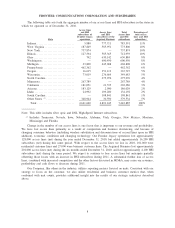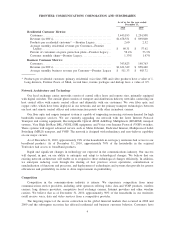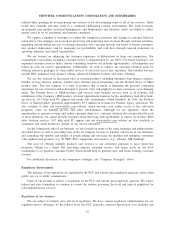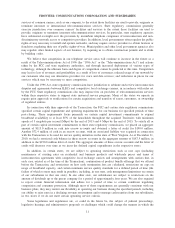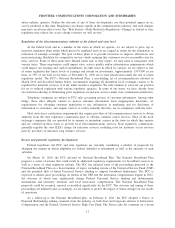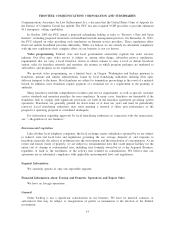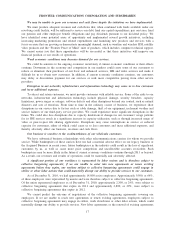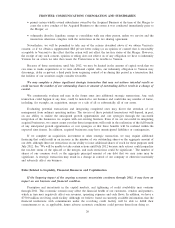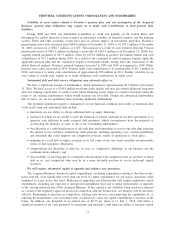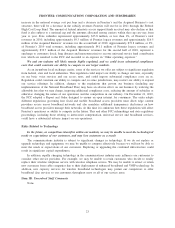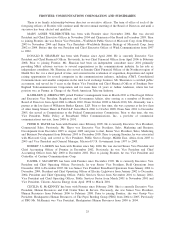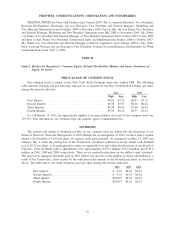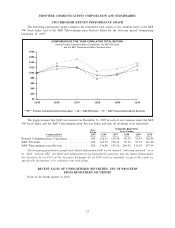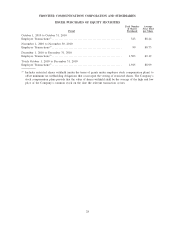Frontier Communications 2010 Annual Report Download - page 19
Download and view the complete annual report
Please find page 19 of the 2010 Frontier Communications annual report below. You can navigate through the pages in the report by either clicking on the pages listed below, or by using the keyword search tool below to find specific information within the annual report.may impose significant new costs on us, which could adversely affect our financial condition and results of
operations in the future.
If we are unable to hire or retain key personnel, we may be unable to operate our business successfully.
Our success will depend in part upon the continued services of our management. We cannot guarantee that
our personnel will not leave or compete with us. The loss, incapacity or unavailability for any reason of key
members of our management team could have a material impact on our business. In addition, our financial
results and our ability to compete will suffer should we become unable to attract, integrate or retain other
qualified personnel in the future.
A significant portion of our work force is eligible for retirement.
As of December 31, 2010, approximately 2,750, or 19%, of our approximately 14,800 active employees
were retirement eligible. If a substantial portion of these employees were to retire and could not be replaced
(and, if necessary, their replacements could not be trained promptly), our customer service could be negatively
impacted, which could have a material impact on our operations and financial results.
Our efforts to integrate our legacy business and the Acquired Business may not be successful.
The acquisition of the Acquired Business was the largest and most significant acquisition we have
undertaken. Our management has been and will continue to be required to devote a significant amount of time
and attention to the process of integrating the operations of our legacy business and the Acquired Business,
which may decrease the time it will have to serve existing customers, attract new customers and develop new
services or strategies. The size and complexity of the Acquired Business and the use of our existing common
support functions and systems to manage the Acquired Business, if not managed successfully, may result in
interruptions in our activities, a decrease in the quality of our services, a deterioration in our employee and
customer relationships, increased costs of integration and harm to our reputation, all of which could have a
material adverse effect on our business, financial condition and results of operations.
We may not realize the growth opportunities and cost synergies that we anticipated from the acquisition.
The benefits that we expect to achieve as a result of the acquisition of the Acquired Business will depend,
in part, on our ability to realize anticipated growth opportunities and cost synergies. Our success in realizing
these growth opportunities and cost synergies, and the timing of this realization, depends on the successful
integration of our legacy business and operations and the Acquired Business and operations. Even if we are
able to integrate the businesses and operations successfully, this integration may not result in the realization of
the full benefits of the growth opportunities and cost synergies that we currently expect from this integration
within the anticipated time frame or at all. For example, we may be unable to eliminate all of the duplicative
costs we expect to eliminate. Moreover, we may incur substantial expenses in connection with the integration
of our legacy business and the Acquired Business. Through December 31, 2010, we have incurred $165.5
million in integration and deal expenses and anticipate that additional expenses will be incurred. However, such
expenses are difficult to estimate accurately. Accordingly, the benefits from the merger may be offset by costs
incurred or delays in integrating the businesses.
Regulatory authorities, in connection with their approval of the acquisition, imposed on us certain
conditions relating to our capital expenditures and business operations which may adversely affect our
financial performance.
In connection with their approvals of the Transaction, the FCC and certain state regulatory commissions
specified certain capital expenditure and operating requirements for our business for specified periods of time
post-closing. These requirements focus primarily on certain capital investment commitments to expand
broadband availability and speeds to at least 85% of the households throughout the acquired Territories with
minimum speeds of 3 megabits per second (Mbps) by the end of 2013 and 4 Mbps by the end of 2015. To
satisfy all or part of certain capital investment commitments to three state regulatory commissions, we placed
an aggregate amount of $115.0 million in cash into escrow accounts and obtained a letter of credit for $190.0
million. Another $72.4 million of cash in an escrow account, with an associated liability was acquired in
connection with the acquisition to be used for service quality initiatives in the state of West Virginia. As of
December 31, 2010, we had a restricted cash balance in these escrow accounts in the aggregate amount of
18
FRONTIER COMMUNICATIONS CORPORATION AND SUBSIDIARIES


